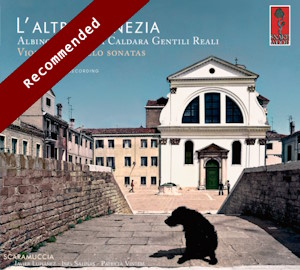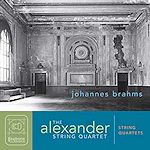
L’altra Venezia
Scaramuccia
rec. 2022, Onze-Lieve-Vrouwekerk, Uitwijk, Netherlands
Reviewed as a stereo 16/44 download with pdf booklet from Snakewoods Editions
Snakewood SCD202301 [78]
No book on music history is complete if it does not include a chapter about Venice. For several centuries it was one of the musical centres of Europe. It was a city no young aristocrat, making his grand tour across Europe, could afford to miss. No wonder, then, that Frederick Augustus II (1696-1763), Prince Elector of Saxony, visited the city in 1716, and stayed there for six months. In his retinue was, among others, Johann Georg Pisendel, first violinist of the Dresden court chapel. He took the opportunity to establish contact with Antonio Vivaldi and Tomaso Albinoni, two of the leading composers of the time, and also brilliant violinists, like himself. Both offered him some of their sonatas, which was a clear token of their appreciation of his skills. Back in Dresden, Pisendel did not restrict himself to what was given to him, but continued to collect Italian music, and this resulted in a large collection of Vivaldi manuscripts which became part of the library of the Dresden court chapel.
Whereas Vivaldi is one of the most frequently-performed and -recorded composers of the Venitian Baroque, some of his contemporaries have fared considerably worse, and that includes Albinoni. The disc under review attempts to correct the picture and deliver them from the shadows of Vivaldi. Among them are some composers who are hardly known (Gentili, Reali), but also household names, whose contributions to the repertoire for violin and basso continuo is not commonly known.
One of them is Albinoni. He is well-known enough by name, but only a few parts of his large oeuvre are regularly performed. His best-known works are the concertos with parts for one and two oboes. As far as his violin sonatas are concerned, the set of sonatas Op. 6 is part of the standard repertoire, but even those pieces are not that often performed. Michael Talbot, the author of the liner-notes to the present recording, stated elsewhere: “In the past, the undemonstrative nature of Albinoni’s musical personality has puzzled some commentators. (…) Today, the subtle elegance and lack of exaggeration in Albinoni’s music comes across, rather, as a positive feature essential to his musical personality”. It is one of the reasons I really like his music. I was very pleased to listen to the recording by Guillaume Rebinguet-Sudre (review), which includes one sonata from a set of three that Pisendel received from Albinoni. The two sonatas performed here were discovered in 2021; they are included in a manuscript preserved at the Austrian State Library in Vienna. The two pieces don’t mention the composer, but Talbot has no doubts that they are from Albinoni’s pen. They are in the common four-movement form. Despite the description of Albinoni’s style by Talbot, they are not devoid of virtuosity, but what is most striking is their expression, which is beautifully conveyed here. The dramatic pause in the second adagio of the Sonata in B flat shows that – as basically in all Italian music – the theatre is never far away.
The second household name is Antonio Caldara. Again, here is a composer who was a celebrity in his time, but who is not treated on equal footing with Vivaldi. His main contributions to the history of music are in the field of vocal music. For most of his life he was in the service of the Habsburg court in Vienna, where he wrote a large number of operas, oratorios and other vocal music. In his early years he composed trio sonatas, and far later in his career a number of sonatas for cello and basso continuo, at the request of Prince Rudolf Franz Erwein von Schönborn. Caldara was educated at the cello, and included arias with obbligato cello parts in some of his large-scale vocal works. His oeuvre does include some violin sonatas; New Grove mentions eight, and the Sonata in F performed here may be one of them. It is in five movements, and includes double-stopping. Talbot compares Caldara in this piece with Vivaldi, and the technical challenges support that view.
The three other composers are largely unknown quanties. In the case of Diogenio Bigaglia that is rather surprising. He made a career in the church, but also wrote a substantial amount of liturgical music and some oratorios. In the field of instrumental music, he published a set of twelve sonatas for violin or recorder and basso continuo as his Op. 1 in Amsterdam (c1722). These seem to be played now and then, although I have to confess that I can’t remember ever having heard them. The Sonata in C is part of the library of the Dresden court chapel. It is a copy made by Pisendel during his Venetian sojourn. Again, the name of the composer is not given, but the stylistic similarity with the Op. 1 sonatas points in Bigaglia’s direction. There is some double stopping here as well, but in particular the slow movements are notable for their expressive features. They are emphasized by Javier Lupiáñez’s beautiful and imaginative ornamentation.
Giorgio Gentili is another composer, whose relative obscurity is rather surprising, as he was one of the most prominent violinists of his time in Venice. He acted as first violist at the ducal chapel of St Mark’s, and that is no position for just anyone. Between 1701 and 1716 he published six collections of chamber music, each consisting of twelve pieces. The Capriccio XI in B minor has indeed a capricious character; the first of the five movements sets the tone. However, for me the real discoveries are the two pieces for cello and basso continuo, which have been preserved in manuscript. Talbot reckons them among the early pieces for this instrument. The ‘baroque cello’, as we know it today, entered the scene in the last quarter of the 17th century, and it was mainly in Bologna that it enjoyed its main success. Gentili must be one of the first composers in Venice to write music for it. These are very fine pieces, and valuable additions to the repertoire. It is nice that Inés Salinas, whom I know as an excellent basso continuo player, has the chance to show her skills in a solo role. And how well she plays these two sonatas. The second allegro of the Sonata in A is one of the highlights of this disc.
The last composer is Giovanni Battista Reali, about whom very little is known; he has no entry in New Grove. Recently Alpha released a recording in which the French ensemble Le Consort puts him alongside Vivaldi with some of his trio sonatas (review). It was a most pleasant acquaintance, and my positive impression of his trio sonatas are confirmed here with the Sonata in B flat. “Reali’s sonata is without surprises: graceful and fluent”, Talbot writes. It is a fine piece to listen to; even without surprises one can enjoy a piece of music, if it is really good, and this piece is good.
Scaramuccia is one of those ensembles that like to leave well-trodden paths and are eager to explore hidden treasures. Their previous recording was devoted to Johann Georg Pisendel (review), and included several hitherto unknown sonatas. In a way, this disc is a logical sequel, given the connection between Pisendel and Venice, and his personal contacts with Albinoni, and probably Bigaglia as well. The performances are in line with the ensemble’s previous recordings. They are engaging and imaginative, and also do full justice to the theatrical nature of the repertoire, for instance through strong contrasts in tempo and marked dynamic shading. I already mentioned the way in particular slow movements are ornamented. There are also various cadenzas, which a are just right in character and length.
The combination of music of high quality and outstanding performances, and the fact that we have here largely unfamiliar repertoire, justifies a special recommendation. This disc, accompanied by a booklet with informative liner-notes by Michael Talbot and a list of sources, will undoubtedly be a strong contender for my list of recordings of the year.
Johan van Veen
www.musica-dei-donum.org
twitter.com/johanvanveen
Availability: Snakewood Editions
Contents
Domenico Bigaglia (c1676-c1745)
Sonata for violin and bc No. 2 in D
Antonio Caldara (c1671?-1736)
Sonata for violin and bc in F
Tomaso Albinoni (1671-1750/51)
Sonata for violin and bc in B flat
Giorgio Gentili (1669?-after 1730)
Sonata for cello and bc in A
Capriccio XI for violin and bc in B minor
Sonata for cello and bc in G
Tomaso Albinoni
Sonata for violin and bc in G minor
Giovanni Battista Reali (1681-1751)
Sonata VII for violin and bc in B flat

















